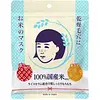What's inside
What's inside
 Key Ingredients
Key Ingredients

 Benefits
Benefits

 Concerns
Concerns

No concerns
 Ingredients Side-by-side
Ingredients Side-by-side

Water
Skin ConditioningDipropylene Glycol
HumectantButylene Glycol
HumectantGlycerin
HumectantPanthenol
Skin ConditioningTrehalose
HumectantBetaine
HumectantHydroxyacetophenone
AntioxidantHelianthus Annuus Seed Oil
EmollientAcrylates/C10-30 Alkyl Acrylate Crosspolymer
Emulsion StabilisingCarbomer
Emulsion StabilisingPotassium Hydroxide
BufferingPrunus Persica Fruit Extract
AbrasiveAllantoin
Skin ConditioningPolyglyceryl-10 Laurate
Skin ConditioningPolyglyceryl-4 Laurate
EmulsifyingEthylhexylglycerin
Skin ConditioningCaprylyl/Capryl Glucoside
CleansingSodium Hyaluronate
Humectant1,2-Hexanediol
Skin ConditioningWater, Dipropylene Glycol, Butylene Glycol, Glycerin, Panthenol, Trehalose, Betaine, Hydroxyacetophenone, Helianthus Annuus Seed Oil, Acrylates/C10-30 Alkyl Acrylate Crosspolymer, Carbomer, Potassium Hydroxide, Prunus Persica Fruit Extract, Allantoin, Polyglyceryl-10 Laurate, Polyglyceryl-4 Laurate, Ethylhexylglycerin, Caprylyl/Capryl Glucoside, Sodium Hyaluronate, 1,2-Hexanediol
Water
Skin ConditioningGlycerin
HumectantPropylene Glycol
HumectantAlcohol Denat.
AntimicrobialStyrene/Vp Copolymer
Lactobacillus/Rice Ferment Filtrate
Skin ConditioningOryza Sativa Bran Oil
EmollientHydrolyzed Rice Bran Extract
Skin ConditioningGlycosphingolipids
EmollientGlucosyl Ceramide
Skin ConditioningAlpha-Glucan
HumectantButylene Glycol
HumectantXanthan Gum
EmulsifyingPolysorbate 80
EmulsifyingCitric Acid
BufferingSodium Citrate
BufferingPhenoxyethanol
PreservativeMethylparaben
PreservativeWater, Glycerin, Propylene Glycol, Alcohol Denat., Styrene/Vp Copolymer, Lactobacillus/Rice Ferment Filtrate, Oryza Sativa Bran Oil, Hydrolyzed Rice Bran Extract, Glycosphingolipids, Glucosyl Ceramide, Alpha-Glucan, Butylene Glycol, Xanthan Gum, Polysorbate 80, Citric Acid, Sodium Citrate, Phenoxyethanol, Methylparaben
 Reviews
Reviews

Ingredients Explained
These ingredients are found in both products.
Ingredients higher up in an ingredient list are typically present in a larger amount.
Butylene Glycol (or BG) is used within cosmetic products for a few different reasons:
Overall, Butylene Glycol is a safe and well-rounded ingredient that works well with other ingredients.
Though this ingredient works well with most skin types, some people with sensitive skin may experience a reaction such as allergic rashes, closed comedones, or itchiness.
Learn more about Butylene GlycolGlycerin is already naturally found in your skin. It helps moisturize and protect your skin.
A study from 2016 found glycerin to be more effective as a humectant than AHAs and hyaluronic acid.
As a humectant, it helps the skin stay hydrated by pulling moisture to your skin. The low molecular weight of glycerin allows it to pull moisture into the deeper layers of your skin.
Hydrated skin improves your skin barrier; Your skin barrier helps protect against irritants and bacteria.
Glycerin has also been found to have antimicrobial and antiviral properties. Due to these properties, glycerin is often used in wound and burn treatments.
In cosmetics, glycerin is usually derived from plants such as soybean or palm. However, it can also be sourced from animals, such as tallow or animal fat.
This ingredient is organic, colorless, odorless, and non-toxic.
Glycerin is the name for this ingredient in American English. British English uses Glycerol/Glycerine.
Learn more about GlycerinWater. It's the most common cosmetic ingredient of all. You'll usually see it at the top of ingredient lists, meaning that it makes up the largest part of the product.
So why is it so popular? Water most often acts as a solvent - this means that it helps dissolve other ingredients into the formulation.
You'll also recognize water as that liquid we all need to stay alive. If you see this, drink a glass of water. Stay hydrated!
Learn more about Water